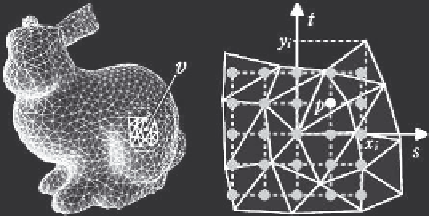Graphics Reference
In-Depth Information
Figure 9.8
Flattening a surface mesh for matching 3D textons (From [Tong et al. 02] c
2002 ACM,
Inc. Included here by permission.)
The paper considers the more general problem of mapping a synthesized BTF
image onto a geometric model. The process begins by creating an analogous 2D
texton surface map on the model as was done on the sample surface. The model
surface is assumed to be a triangulated mesh, so the first step is to assign a texton
to each mesh vertex. The BTF synthesis is done in the local frame of each triangle
vertex, which enables BTF synthesis to handle arbitrary surface geometry. BTF
synthesis results in assigning an appropriate pixel coordinate in the appropriate
reference image to the vertex. In the rendering process, the appropriate pixel in the
original BTF data is copied to the vertex. The synthesis process works by locally
flattening the mesh surface onto the tangent plane at a vertex, as illustrated in
Figure 9.8. Next, 3D textons are assigned to this rectangular grid by interpolating
the textons at the triangular vertices. Finally, the neighborhood of each point
p
in the mesh is matched with a neighborhood of pixels in the BTF image data set,
and the pixel corresponding to
p
is copied to the output image. This matching
computation is efficiently done using 3D textons.
Three-dimensional textons also play an important role in reducing the amount
of data and computation cost of the distance computation. As response vectors
are often high-dimensional vectors, the computation cost of operations on them is
high. However with 3D textons, if the dot product of every possible pair of repre-
sentative vectors of 3D textons is precomputed (if there are
n
textons, the number
of dot products is of the order
n
2
), the distance between any two 3D textons can
be calculated from the dot products. Therefore, the representative vectors of 3D
textons need not be stored explicitly. This reduces the data storage and compu-
tation requirements substantially. Moreover, the precomputed dot products of 3D
textons are also used for interpolating 3D textons.
Because the response vector contains all the filter responses, as do the tex-
tons, the matching of a texton label includes the appearance in a neighborhood
around the point in the spatial and lighting/viewing directions. In contrast, the








